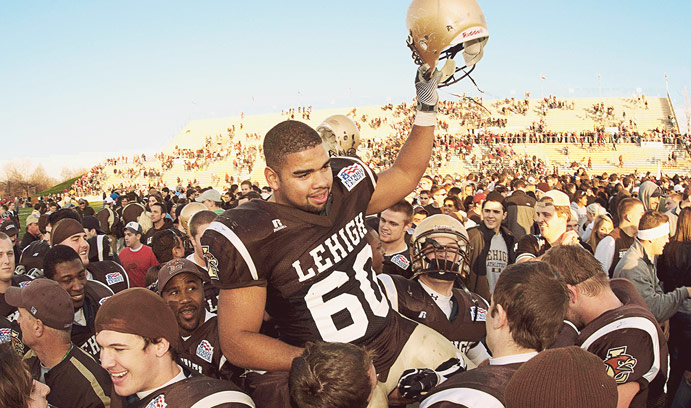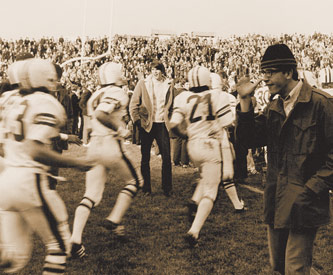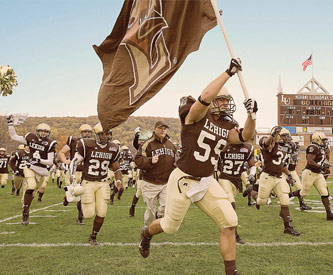The Rivalry of Rivalries

As Lehigh football alumni through the years will attest, there is no sweeter victory than a victory over Lafayette.
There are bigger sports than college football. There are sports that claim more fans and a more global audience. There are sports that make more money than college football, and sports that may be considered more fashionable, especially today.
But at least in one respect, the game of American college football simply has no peer: Rivalry.
Yes, rivalry.
Real, honest, meaningful rivalry. This is a sport, after all, that was quite literally born over a grudge match between students at rivals Princeton and Rutgers, and over the course of its 146-year history, it is a sport that has given birth to countless more rivalries—rivalries big and small and bitter and, well, even more bitter. In many ways, this is a sport that was built on rivalry—on the collective embrace of fierce competition against that school next door, or just across the state line, or maybe, for example, just 13 miles up the road.
There’s simply no debating it. No American sport can match college football for its respect and celebration of rivalry, and all one must do is look around the nation for evidence. There is plenty.
There is Alabama-Auburn down south, in a series so intense that it can rightly be said to border on the bizarre. There is Ohio State-Michigan out in the Midwest, with the Buckeyes so disdainful of the maize and blue that they refuse to utter the name of “The School Up North” at all. There is USC-UCLA in the battle for Los Angeles, Minnesota-Wisconsin in the battle for Paul Bunyan’s Axe, and Oklahoma-Texas each and every year, at the Texas State Fair, with the Cotton Bowl split in two—burnt orange on one side, maroon on the other, and don’t you dare cross enemy lines. There is the Apple Cup and the Centennial Cup and more than a couple Governor’s Cups. There is the Egg Bowl in Mississippi and the Bucket game in Indiana, the Palmetto State grudge match in South Carolina and, down in Georgia, a rivalry series so heated they just call it “Clean, Old Fashioned Hate.” There is Amherst-Williams, Harvard-Yale, Grambling-Southern and, of course, the annual football masterpiece that is Army-Navy.
They are great rivalries all. But they are not “The Rivalry.”
They can’t be. Because while there may be “bigger” rivalry games, or games that draw more fans or more television viewers, there is no rivalry game anywhere in this college football nation that has been played more times than the Lehigh-Lafayette rivalry. Not one.
Entering this season, the Mountain Hawks and the Leopards had played out their annual (and occasionally more than annual) grudge match 149 times. That’s 19 more times than Harvard has played Yale, 32 more times than Auburn has played Georgia in “The South’s Oldest Rivalry,” 35 more times than Navy has played Army and 39 more times than Ohio State has played Michigan. These 149 meetings have seen thrills on the field, stunning upsets, staggering blowouts and sterling individual performances. They have seen legends made, miracles happen, and winning streaks born and broken. They have seen passion and pageantry in the stands, media hype, a few brawls in the stands and a few more on the field, pranks and banter and maybe a few lines crossed. They have seen marching bands and mascots and, of course, an untold number of goal posts torn down.
What these 149 games have seen, in other words, is the development of one of the greatest traditions—and one of the greatest rivalries—that college sports has ever seen. With its unique and unmatched history, then, it is entirely true to say that The Rivalry stands alone.
“I mean, think about it—you’re talking about 150 games,” says Mark McGowan ’89, the quarterback who guided Lehigh to a 17-10 win over Lafayette in the last game ever played at Taylor Stadium. “There’s a lot of tradition built into that. A lot of great players, and a lot of great people who have gone on to do great things in their lives. To learn what it means to be part of a team that has such a great history, it’s really awesome to be part of that. And for a Patriot League player, where 99 percent of the players aren’t going on to play in the NFL, having the opportunity to represent your university in a rivalry like that? That’s the climax of college football right there, just to be part of something like this.”
This year, in honor of the 150th playing of the Lehigh-Lafayette game, the two Lehigh Valley rivals are taking their annual clash on the road —all the way to New York’s Yankee Stadium. There, at 3 p.m. on Nov. 22, the Mountain Hawks and Leopards will take the field and play out the latest chapter in their series in front of more than 40,000 people, not to mention a nationwide television audience.
As they do, they will be given the opportunity to show America precisely what Lehigh and Lafayette alumni have known for nearly a century and a half now: That while Ohio State and Michigan fans may brag on their annual clash and while Alabama and Auburn fans may do the same, while Harvard and Yale celebrate The Game and while the Long-horns and Sooners hold dear The Red River Rivalry, Lehigh vs. Lafayette is every bit as passionate, every bit as heated and every bit as important—to the players, to the coaches, to the students, and the alumni—as every other rivalry in the nation.
Just ask the guys who have played in it.
“I remember speaking to a reporter one time after the Lehigh-Lafayette game of my senior year, and he asked me, ‘I know this is a big game, but do you get the sense that because you play the same weekend as all of these other rivalries that you sometimes don’t get the credit you deserve?’” recalls Mark Yeager ’81. “And I remember telling him, ‘Look, nobody in this locker room has any delusions of grandeur. Few of us have even thought about pursuing a career in the NFL. But that does not in any way demean what this game means to us. Winning this game is every bit as important to our coaches, our families, the players, the schools and the students as any other rivalry game. It may be less impactful of the national championship picture. But don’t doubt that it’s every bit as important.’”
‘Just a Little More Electric’
Talk to enough Lehigh football alums and you’ll eventually collect a treasure trove of great stories about The Rivalry.
One will tell you about how, months after a last-minute loss to the Leopards, his coach opened spring practice not with the typical warm-ups—stretching, or calisthenics—but rather by having his team run the exact same play that failed, with the clock running out, all those months before. Another will recall the immense pressure he and his teammates felt to get a win in the very last Lehigh-Lafayette game ever played at Taylor Stadium—a game played out in almost unbearably cold temperatures. Another will tell you about the bittersweet victory in his freshman year over a Lafayette team that happened to include his big brother, a senior at the time, who with that stinging defeat saw his football career end in the worst way possible—a loss to hated Lehigh. Still another will talk about the fleeting moment of joy he experienced, down on the field of old Taylor Stadium, when in the midst of the frenzied game day atmosphere he simply stopped, took in the hectic and colorful scene surrounding him, and realized that, yes, he was truly part of something special.
Some recall individual plays of brilliance or heartbreaking moments of defeat. Some remember the first time they got hit by a Leopard—or the first time they hit a Leopard. Some can’t help but laugh in disbelief about traditions of old—of the crazy old days when students on both sides would literally go to war over a piece of the Lehigh-Lafayette goalposts, and when being on the sidelines, with a helmet on, was really the safest place to be. Others still, mostly the guys who were raised here in the Lehigh Valley, will get emotional talking about how they grew up with the Lehigh-Lafayette game, how they started coming to the game with their father or grandfather, and how their playing in the game felt like a certain kind of destiny fulfilled.
The stories run the gamut—triumph, heartbreak, comedy, victory. And yet, there is one theme, and one idea, that ultimately ties all of their stories together. That idea is this: No matter when they played in The Rivalry, be it back in the post-war 1940s or the turbulent 1960s, the heady 1980s or the early 2000s, each and every playing of this game has really, really mattered.
All of these games through the years have mattered to the players. To the coaches. To the students and staff, faculty and alumni. To all of them, across the eras, the rivalry has mattered—for the competition, for the bragging rights, for the week-long celebration that surrounds it, for the memories it manufactures. It continues to matter today.
“It’s the entire student body. It’s the faculty and staff. It’s everybody associated with both of those universities really getting into it,” says Rennie Benn ’86. “The players and coaches are one thing. But to get to that level beyond the student body? To get up into the staff and the administration? That’s when you get a sense pretty quickly of how big it is.”
“There was always a lot of hoopla,” says Walt Pijawka ’58. “And let’s face it, Lehigh always had a penchant for partying. This was a great opportunity for a party.”
Lehigh, as even its football alums will tell you, is not a football factory. The game as played here remains in many ways just that—a game. Lehigh football players are expected to be true student-athletes, Lehigh football is not a multimillion- dollar enterprise, as many major college football programs are, and Lehigh fans do not cross the line into fanaticsism the way fans of those “big-time” programs might. Except, of course, for the one week each season when they do.
During Spirit Week, South Mountain is a campus transformed—a place abuzz with excitement and anticipation for the Saturday showdown to come. That buzz—that electricity that makes campus just feel a little bit different than any other time of the year—is something that most every player who has worn the brown and white has experienced. And even when their Spirit Week experience is decades in the past, it’s an experience they still appreciate, and still treasure, even today.
The fact that it mattered so much to everyone else on campus?
Well, in some ways, that made it matter so much more to them, too.
“What I remember most is the buildup to the game,” says Kody Fedorcha ’00. “The campus is just different. You can start to feel it when that week hits. It’s just not the same. You see guys walking around on campus and they know you play football, and they’ll make comments to you. You’ve got the band playing in the classrooms, everyone gearing up for it. You know it’s a big-time game.”
“Look, I’ve done the Harvard-Yale game twice,” says John Shigo ’84, a former Lehigh linebacker who now works as a college football referee. “Lehigh-Lafayette is very similar in regards to the buildup. You’ve got the amount of people there, the tailgating, the flag-waving. It gets hyped on the television and through the media. You just know it’s a different kind of game. It’s just a little bit more electric.”
‘A Different Mindset’
And then, of course, there is game day itself.
For the rest of the campus community, there are the tailgates and the pregame rituals, the banter and the reunions. But for the guys who actually play the game? Well, mostly, there are the nerves. And the anxiety. And perhaps most of all, that enormous weight of responsibility—responsibility to their friends and classmates and teammates to bring back a win, to give Lehigh another year’s worth of bragging rights, to write another winning chapter in the proud history of a great football program that has been blessed with a truly great rivalry.
“Coming into Lehigh, one of the first things the older guys tell you is, ‘You don’t lose to Lafayette—in anything,’” adds former tailback Keith Sherman ’14. “Hearing that message from those guys, you just know right away that it really means something. … You get that feeling that it’s about much more than just what’s happening on the field.”
To run onto the field for a Lehigh-Lafayette game, these former players say, is an experience unlike any other they ever had in football. It’s thrilling, overwhelming, humbling. And in truth, they say, it’s actually something that takes some getting used to.
Freshmen, most of the time, just aren’t ready for it. They can’t be.
“When you are playing in a Lehigh-Lafayette game, you have to have a different mindset,” says Benn. “The first couple of times I played in it, I went in thinking that it was like any other game—that all of our games were equally ‘big’ games. But then I realized you can’t do that. By my junior and senior years, I understood that you needed to be really prepared mentally for the game. There is so much emotion in it.”
“It’s just phenomenal,” adds former linebacker Mike Yadush ’93. “I think the older guys tried to prepare us for it, but you really don’t get it until you experience it."
Which raises a question. What does it mean, really, to “get it”?
It means racing down the field, as a true freshman, making a tackle on the opening kick and hearing a roar that you’ve never heard before. It means playing your heart out for the seniors, because after all they gave to the program, the one thing they deserve, more than anything else in the world, is to go out with a win over Lafayette. It means consoling those seniors when the Leopards win the day, it means never forgetting just how bad it felt to lose, and it means promising your teammates that next year won’t be another failure. It means understanding that most every single play of most every single playing of this game will never be forgotten, and it means being wise enough, even in the heat of battle, to take a breath, look around and appreciate what a wonderful thing this rivalry is—and how fortunate you are to have played in it.
Because while some may say it’s just a football game, it’s really so much more than that.
It’s an event.
It’s a celebration.
It’s The Rivalry.
And there really isn’t another one like it.
Posted on:



